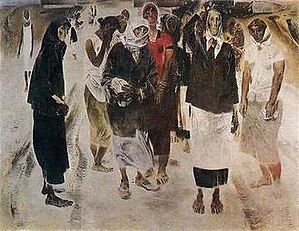Year 1967 Artist Evsey Moiseenko | Medium Oil on canvas Created 1967 | |
 | ||
Dimensions 200 cm × 257 cm (80 in × 102 in) Location State Russian Museum, Saint-Petersburg Similar Cherry, Portrait of Catherine Balebina, Cafe Gurzuf, House with Arch, Russian Winter Hoarfrost | ||
Mothers sisters daughters wives
″Mothers, Sisters″ (Russian: ″Матери, сёстры″) is a painting by Russian artist Evsey E. Moiseenko, (1916–1988).
Contents
History
Painted in 1967, Mothers, Sisters was devoted to the destiny of Russian women in the years of the Great Patriotic War. It was created during five months, but its idea was born at the beginning of the Russo-German war in 1941 and based on the artist's personal knowledge. "I remember my mother when she saw me to the war and how I came in and went away the villages when I was a soldier. I couldnt forget the eyes of women. I have wanted to peep into them with my outgoing look" — Moiseenko was reminiscing. The first sketch was made by the artist in 1965. Later he refined it in numerous preparatory sketches. There are many of these sketches in the Museum of the Russian Academy of Arts. He made them in the 1960s in his native village of Uvarovichi, where he found the female characters for the painting. Among them are "Woman with Girl", "Ljuba", "Nastja" and many others. The first variant of the painting was a big canvas, At the Collective Farm`s Yard (Oil on canvas, 200х257. 1966) The second version was named Mothers, Sisters. Mothers, Sisters was first presented at the largest exhibition "Soviet Russia" in Moscow in 1967 and later in a large exhibition devoted to the fiftieth anniversary of the October Revolution, also in Moscow. The Leningrad Union of Soviet Artists and Leningrad Culture Committee awarded this painting the Medal "For the Best Painting of the Year". The work is dedicated to the mother of Moiseenko. Her destiny was typical for the war times. She went four years without even a letter from her son. Moiseenko painted her image as an old woman, although she was young at the time of the war. Using the innovative experience of Soviet painting, especially an advancement of Aleksandr Deyneka, Moiseenko applied the method of assembly composition in Mothers, Sisters. The picture portrays some women saying goodbye to men leaving for the front. A lorry carrying soldiers has just driven off. Only women - mothers, sisters, wives - are standing on the road. The expressions on their faces convey a variety of feelings: uncomplaining grief, fortitude and readiness for hardship and struggle. A well-known art-critic, Mikhail German, characterized Mothers, Sisters as one of the most powerful and tragic of Moiseenko's paintings. The Russian Museum has "Mothers, Sisters" in its collection.
